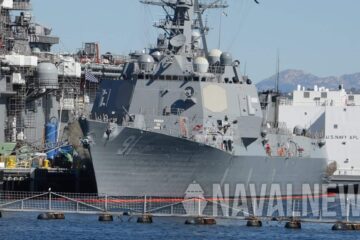Naval News provided video coverage of the Austal USA’s new Medical Expeditionary Ship concept at Sea Air Space 2021.
SEAPOWER magazine reported the news on the U.S. Navy’s Expeditionary Fast Transports (EPFs) having expanded medical capabilities. According to SEAPOWER, the modified EPFs will have “significant structural changes’ for medical facilities, including an 18-bed intensive care unit, two operating rooms, and feeding and berthing for a medical team of about 100 personnel. Its flight deck would be capable of landing helicopters and V-22 tiltrotor aircraft.”
Naval News reached out to the U.S. Navy’s Chief of Information Department (CHINFO) in August 2021 for more details. U.S. Navy Lieutenant Lewis Aldridge of CHINFO replied by stating:
“The Navy continues to expand Role 2 afloat medical capability through construction of USNS Cody (EPF 14) and Point Loma (EPF 15). Role 2 provides limited hospital capability consisting of advanced resuscitation and surgery. The Navy also continues the sustainment of the two T-AH hospital ships, which offer Role 3 medical capability. Role 3 provides full, but short-term, hospital capability, consisting of surgery, intensive care, postoperative care, and specialty care.”
The U.S. Navy has confirmed the expanded medical capabilities of EPF 14 here and for EPF 15 here.
Naval News Comments

For purely speculative analysis, to give an idea of the impressive medical capabilities the two USNS (T-AH) Mercy-class ships provide, consider these impressive statistics on the USNS Mercy:
| “General Characteristics, Mercy-class |
| Builder: Built and converted by National Steel and Shipbuilding Co., San Diego, Calif. |
| Propulsion: Geared steam turbine, 2 boilers, 1 shaft, 24,500 horsepower |
| Length: 894 feet (272.6 meters) |
| Beam: 106 feet (32 meters) |
| Displacement: 69,360 tons (70,473.10 metric tons) full load |
| Speed: 17.5 knots (20.13 mph) |
| Crew: 71 CIVMARs plus up to 1,200 medical personnel |
| Aircraft: Helicopter platform and hanger. Helicopters assigned for specific missions. |
Patient capacity:
- Intensive care wards: 80 beds
- Recovery wards: 20 beds
- Intermediate care wards: 280 beds
- Light care wards: 120 beds
- Limited care wards: 500 beds
- Total patient capacity: 1000 beds
- Operating rooms: 12
Departments and facilities:
- Casualty reception
- Radiological services including CT
- Main laboratory plus satellite lab
- Central sterile processing
- Medical supply/pharmacy
- Physical therapy and burn care
- Intensive care unit
- Dental services
- Optometry/lens lab
- Morgue
- Laundry
- Burn treatment
- Angiography
- Blood bank
- Oxygen producing plants (two)”

As Naval News reported previously, information released during Sea Air Space 2021 shows that the current EMS design is a 118 meters-long catamaran with a beam of 30 meters and a draft of 4.5 meters. The Austal’s hospital ship can sail over 2,000 nautical miles at a cruise speed of 18 knots and can reach a top speed of 27 knots. It features a helicopter deck large enough to accommodate one V-22 Osprey, a CH-53 Sea Stallion or a Sikorsky H-60. The ship has a total of 185 berthing including the crew, medical and aviation personnel.
Regarding its medical facilities, the EMS would have 124 medical beds in total including four operating rooms, 8 isolation beds, 32 light care beds and 80 ER, ACW, ICU and recovery beds.
The intended goal of the medical EPFs will be to build enough of them to provide faster and closer expeditionary medical relief in multiple areas of the world compared to relying on just the two T-AH hospital ships, USNS Mercy, stationed on the West Coast, and USNS Comfort, stationed on the East Coast of the United States.






